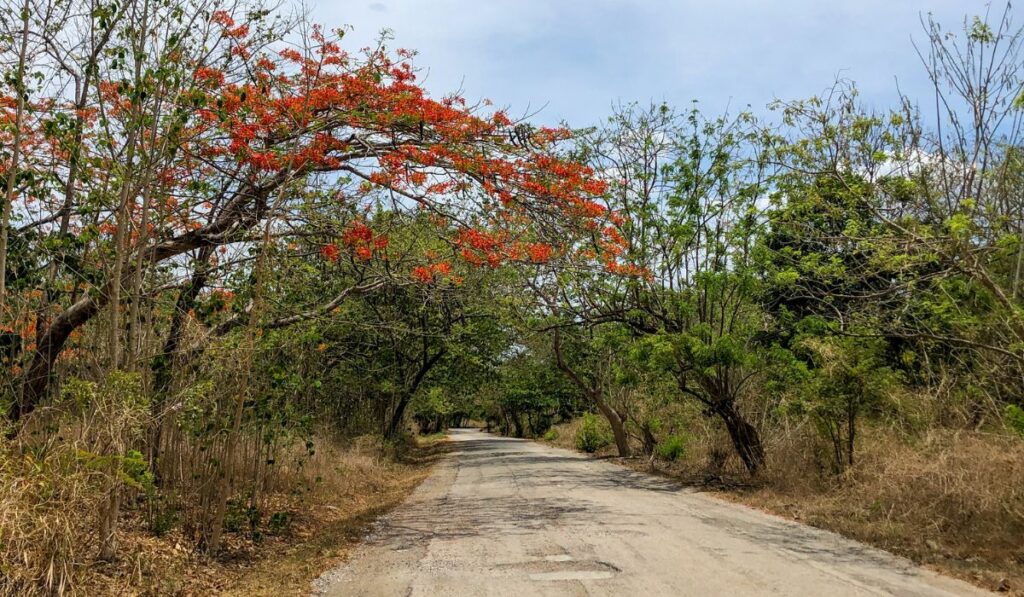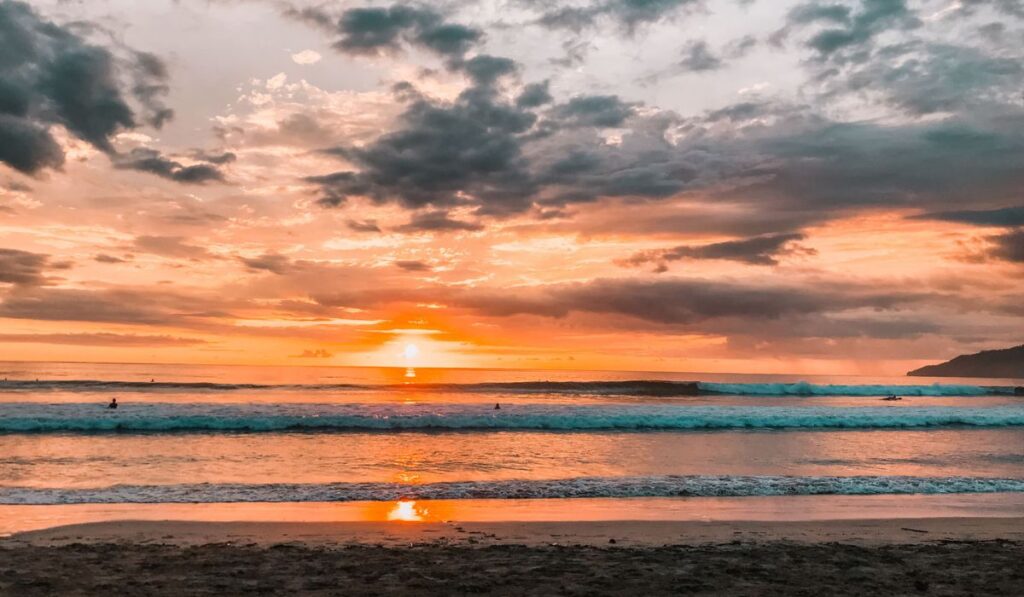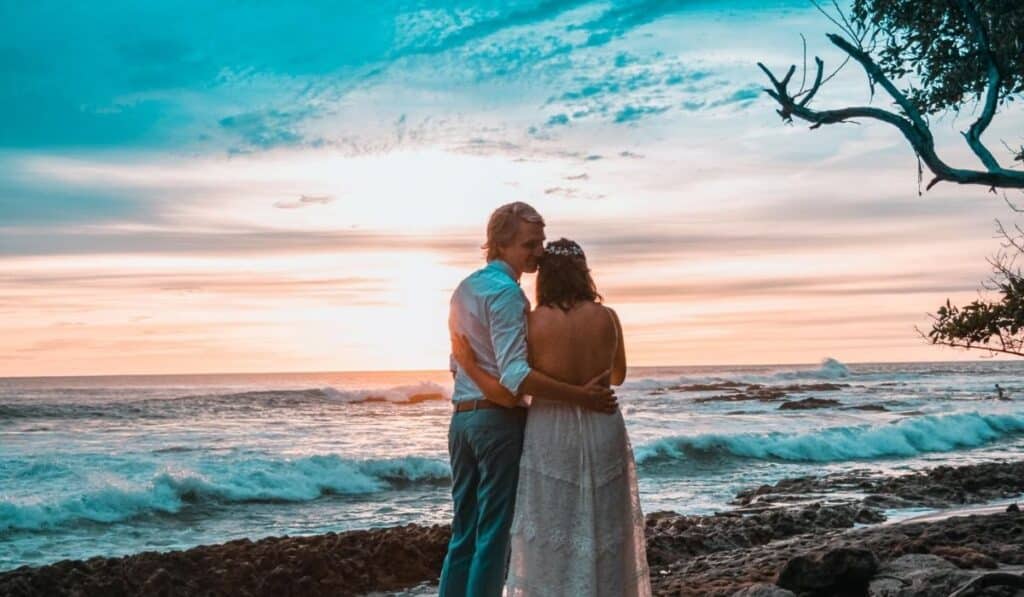Disclaimer: This article may contain affiliate links. Clicking on them may earn Costa Rica Vibes a commission, at no extra cost to you. Thank you for your support!
Full Guide to the Weather in Tamarindo, Costa Rica by Month
Are you wondering about the weather in Tamarindo, Costa Rica for your next trip?
Tamarindo is located on Costa Rica’s North Pacific coast in what is known as the Guanacaste Province. It is a popular destination known for its stunning beaches, lively surf scene, and vibrant nightlife. Tamarindo enjoys a tropical climate with a distinct dry season from December to April and a rainy season from May to November.
As frequent visitors to Tamarindo, we’ve experienced its weather in all its forms. From the sun-soaked days ideal for surfing and beach lounging to the rainy season that brings the landscape to life, we’ve seen it all.
We created this guide to provide you with a month-by-month breakdown, packing tips, and recommendations on the best activities for each season.
Let’s explore the weather in Tamarindo!

Tamarindo Weather at a Glance
- Dry season: Late November to mid-April
- Rainy season: Late April to early November
- Heaviest rainfall: September and October, with October typically being the wettest month, averaging 14.3 inches (362 mm) of rain
- Hottest months: March and April, with average highs around 94°F (34°C)
- Coolest months: September and October, with average highs around 85°F (29°C)
- Sunrise and sunset: The sun typically rises around 5:30 AM and sets around 5:45 PM throughout the year
The Forecast for the Next 7 Day Is….
TAMARINDO WEATHERTamarindo’s Dry Season (December to April)

Tamarindo’s dry season means hot, sunny days, minimal rainfall, and relatively low humidity.
This area is known for having some of the driest weather in the country year round, so expect the landscape to dry out a lot throughout this season.
This season attracts a large number of tourists and Tamarindo is a popular place for surfers, backpackers, and families looking to escape colder climates.
The town is lively, with plenty of activities and events, and the ocean conditions are generally favorable for water sports.
In other words, if you visit during the dry season we suggest booking your trip as far in advance as possible. This is such a popular area that things tend to be booked out early.
- 10% Discount on your rental car with our favorite local company, Adobe
- Book your hotel with Booking.com for great cancellation
- Book your activities on Viator for secure payment and great cancellation policies
December
December marks the beginning of the dry season in Tamarindo. Expect clear skies, warm temperatures, and a festive atmosphere as people gear up for the holiday season.
The ocean is generally calm and clear, making it ideal for swimming, snorkeling, and other water activities.
The town gets busy between Christmas and New Year’s when Costa Ricans are also on vacation. Expect that the beaches will be very crowded and that there may be more traffic.
Also, expect that some businesses will be closed during that week as people take time to celebrate with their families.
If you are looking for something fun to do on New Year’s Eve, this town is known for having a great nightlife scene.
- Weather: Average daytime temperatures reach 89°F (32°C), with evening temperatures around 72°F (22°C).
- Rainfall: Approximately 1.7 inches (4.3 cm), mostly in brief showers early in the month.
- Humidity: Moderate, around 70%.
January
January is one of the driest and most popular months in Tamarindo. With almost no rain and plenty of sunshine. It’s perfect for enjoying the beach and outdoor activities.
This is peak tourist season, with crowded beaches and full hotels. Definitely book far in advance if visiting at this time of year.
The roads are busy, particularly on weekends when people from Liberia and San Jose make their way to the beaches.
Also, keep in mind that schools in Costa Rica are on break until late January, so there is a huge increase in domestic tourism as well.
The landscape starts to turn brown, but there is still a little bit of greenery.
The ocean remains calm. It is a great time for water sports such as fishing and surfing. Because the waves are smaller at this time of year, it is great for beginner surfers.
- Weather: Average daytime highs are around 91°F (33°C), with nighttime lows around 70°F (21°C).
- Rainfall: Less than 0.4 inches (1 cm).
- Humidity: Low, around 65%.
February
February continues the trend of hot, dry weather with slightly warmer temperatures.
The conditions remain ideal for outdoor activities and exploring Tamarindo’s surroundings.
At this time of year, the landscape starts to look very arid due to the lack of rain.
High levels of tourism continue, but schools in the country will have started back up again. That means there is a decrease in domestic tourism.
However, expect continued high prices and for things like hotels and activities to book out in advance.
- Weather: Daytime temperatures can reach up to 93°F (34°C), with evenings dropping to around 72°F (22°C).
- Rainfall: Minimal, around 0.2 inches (0.5 cm).
- Humidity: Low, around 63%.
March
March is typically the hottest month in Tamarindo, with temperatures frequently reaching the mid-90s°F.
Despite the heat, the clear skies and warm weather make it a popular time for beachgoers and surfers.
The climate is especially dry by this point. Sometimes there are even forest fires in the hills above Tamarindo due to the lack of rain.
- Weather: Daytime temperatures average 94°F (34°C), with nighttime temperatures around 73°F (23°C).
- Rainfall: Around 0.1 inches (0.3 cm), very rare showers.
- Humidity: Low, around 62%.
April
April is the last month of the dry season. Temperatures peak and the first signs of rain appear towards the end of the month.
If you do experience rain towards the end of the month it is typically only a brief shower in the afternoon around 2PM.
There are a lot of international tourists over the week before and after Easter. Locals also often have the week before Easter off of work and school. Everyone flocks to the beaches and things get a bit crazy. Check out our guide to Easter in Costa Rica for all the details.
If you plan to visit this area over those two Easter weeks, book as early as possible.
- Weather: Average daytime highs reach 95°F (35°C), with nighttime lows around 74°F (23°C).
- Rainfall: Rainfall begins to increase slightly, averaging 1.3 inches (3.3 cm).
- Humidity: Begins to rise, averaging around 68%.
Tamarindo’s Rainy Season (May to November)

The rainy season in Tamarindo is characterized by frequent afternoon showers, lush green landscapes, and a significant drop in tourist numbers.
Mornings are typically sunny and clear but, the afternoons often bring heavy rains. This gets more intense as the season progresses.
The perk is that prices go down by a lot and there are fewer tourists.
May
May marks the beginning of the rainy season in Tamarindo, with increased rainfall and a noticeable drop in the number of tourists.
Typically the rain will start around 2 PM and last for an hour or two. You might also experience days with no rain at all.
The landscape begins to green rapidly, with rivers and waterfalls becoming more active.
The ocean can become rougher, with larger waves ideal for experienced surfers. Visibility for snorkeling and diving may decrease.
Traffic also becomes lighter, but road conditions can deteriorate during heavy rains.
- Weather: Daytime temperatures average 90°F (32°C), with nighttime lows around 74°F (23°C).
- Rainfall: Increases significantly to around 4 inches (10 cm).
- Humidity: High, around 75%.
June
June brings regular afternoon rains. This helps restore the lush and vibrant landscape. Mornings are often sunny and pleasant.
This is often a quieter month for tourism and I think it is a good time to visit the area. Just wake up early and enjoy the day before the rain starts. Then take a little siesta or read a good book (here are some great Costa Rica book suggestions) and get back up to watch the sunset and get dinner.
- Weather: Daytime highs are around 88°F (31°C), with evening temperatures cooling to 73°F (23°C).
- Rainfall: Around 6 inches (15 cm) of rain, mostly in the afternoons.
- Humidity: High, around 78%.
July
July is known for the “veranillo” or “little summer.” This is a brief period during which the rains temporarily subside for about two weeks. However, this is very hard to predict. Some years this happens and sometimes it doesn’t. I wouldn’t suggest that you plan your trip around it.
Thomas and I got married a few years ago just south of Tamarindo and we chose July 3rd as our wedding date. The day before our wedding there was a crazy storm with flooding and a lot of lightning. However, on our wedding day, there wasn’t any rain and the next few days were mostly rain-free as well. So, it is so difficult to fully predict.
Keep in mind that there can be a slight uptick in tourism in July because schools are typically closed for a few weeks during this time of year. A lot of families from the cities will head to the beach towns for a mid-year vacation.
- Weather: Average daytime temperatures are around 87°F (31°C), with nighttime lows near 73°F (23°C).
- Rainfall: Slightly lower at around 5 inches (12.7 cm).
- Humidity: High, around 77%.
August
August sees the return of heavier rains, with frequent and intense afternoon showers. The mornings typically remain warm and sunny, but you might experience some overcast days.
The ocean becomes rougher, with larger waves and stronger currents. It can be a great time for surfing but not so great for swimming or boat trips.
Prices for hotels, activities, and rental cars tend to go down a lot at this time of year.
- Weather: Daytime temperatures average 86°F (30°C), with nighttime lows around 72°F (22°C).
- Rainfall: Increases to around 7 inches (18 cm).
- Humidity: Very high, around 80%.
September
September is one of the wettest months in Tamarindo. There are often frequent, heavy rains that can last throughout the day and into the night.
Despite the rainfall, the mornings are often clear.
- Weather: Average daytime temperatures are around 84°F (29°C), with nighttime lows around 72°F (22°C).
- Rainfall: Peaks at around 9 inches (23 cm), making it one of the wettest months of the year.
- Humidity: Extremely high, around 83%.
October
October is the peak of the rainy season in Tamarindo, with the heaviest and most consistent rainfall.
This month sees the most significant impact from the rains, with potential flooding and road closures in some areas.
Also, a lot of hotels and restaurants will close in October because there just isn’t enough demand.
- Weather: Daytime temperatures are around 82°F (28°C), with nighttime lows around 71°F (22°C).
- Rainfall: The highest of the year, averaging 10 inches (25.4 cm).
- Humidity: Very high, around 85%.
November
November is a transitional month. The rains can still be heavy at the beginning of the month, but typically the rainy season begins to taper off towards the end of the month.
Tourism starts to pick up slightly as the dry season nears, but it remains relatively quiet.
- Weather: Average daytime temperatures are around 84°F (29°C), with nighttime lows around 72°F (22°C).
- Rainfall: Decreases to around 6 inches (15.2 cm), though still substantial.
- Humidity: Remains high, around 83%.
Packing for Tamarindo in Both Seasons
Here are the things we suggest packing for both the dry and rainy seasons in Tamarindo.
Year Round Essentials
- We suggest carrying your stuff in a large backpack instead of a suitcase if possible. The Osprey 55L is great if you are only bringing a carry-on (take the small bag part off for under your seat) and the Osprey 75L is our go-to for checking in a bag.
- Sun Bum Original SPF 50 Sunscreen: SPF 50 because the sun is powerful. We like Sun Bum because they are reef-safe.
- Teva Voya Flip Flops for men and for women: Waterproof and have a solid sole.
- Columbia Bora Bora Sun Hat: Slightly nerdy, but great for blocking the sun, folding up small in your luggage, and is made of breathable fabric.
- Sun Bum Cool Down Aloe Vera Lotion: Hopefully you don’t get sunburned, but if you do, this stuff is a lifesaver.
- Hero Microfiber Towel: Most hotels will have towels for showering, but not for the beach, Microfiber towels dry quickly and can easily fit in your luggage.
- LifeStraw Go Water Filter Bottle: You can drink the water here, but it is safer to buy bottled water. We like LifeStraw to filter out any extra bacteria or impurities.
- Insect Repellent: Once the sun goes down the mosquitos come out in full force. It is worse during the rainy season, but you might experience them in the dry season as well.
Rainy Season Essentials
- The Anker Powerbox: A reliable battery pack to charge electronics if power goes out.
- Large Zip Lock Bags: Nothing ever dries in the rainy season. Zip locks are great for separating damp clothing in your luggage.
- Rain Jacket: I love the North Face Antora for women and the same jacket for men. Lightweight, breathable, efficient.
- Waterproof Backpack: We use ours year round because it is also great for the beach and boat trips, but especially good in the rainy season for potentially wet adventures.
- Motion Sickness Pills: You might want these year-round for navigating the crazy roads. However, they are especially helpful in the rainy season if you plan to do a boat trip when waves can be bigger.
- Headlamp: Again, useful all year round since the sun sets by 6PM. Also great to have if the power goes out.
Fun Things to Do in Tamarindo in Both Seasons
Most of these activities can be done year-round, but involve a few weather considerations.
If visiting during the dry season I suggest booking activities early because things get very full.
If visiting during the green season I suggest planning and booking your activities for in the morning so you can enjoy them before the rain starts.
- Go Surfing: This town is one of the best places for surfing in Costa Rica. If you are a more advanced surfer, the conditions are best in the rainy season. There are TONS of surf shops in downtown Tamarindo where you can rent a board. If you are a beginner, the dry season is best. If you would like to take surf lessons, we recommend Iguana Surf Camp. Check Availability and Book Your Surf Lesson 🏄
- Take an ATV Tour: We love taking ATV tours in Costa Rica and Tamarindo is the perfect place for this activity because it has a great mix of rugged hills, lush jungles, and beautiful beaches. This is great year round, but it can be muddy in the rainy season. Check Availability and Book Your ATV Adventure
- Go Fishing: From Tamarindo, it is possible to take half or full-day fishing trips either inshore or deep sea. You might catch sailfish, yellowfin tuna, mahi mahi, marlin, and more! Sea conditions are best in the dry season, but what you target will be different throughout the year. Book Your Trip with Captain Noah of Sea Breeze Fishing
Check out Our Guide to the Best Activities in Tamarindo for more ideas
Safety Concerns by Season
- The sun is very powerful here. You really need to take sun protection seriously because it is so easy to get burned. I suggest wearing long-sleeved swim shirts in the water, staying in the shade as much as possible, and wearing SPF 50+.
- It is very easy to get dehydrated with the strong sun. Drink a lot of water and replenish your electrolytes when you can. Most stores sell Gatorade or Powerade, which I find really helps here.
- Because it is so hot you might find that you get worn out a lot quicker than you are used to on hikes and with other activities.
- During the rainy season, rip currents and big waves are more common. Be careful about where you are swimming and obey any posted signs.
- Crocodiles have been known to end up in the ocean from the river mouth in Tamarindo. Be very careful about swimming and surfing in the river mouth area. This is more of an issue during the rainy season as the rivers flood and they get pushed downstream.
- You typically do not need a 4×4 rental car here, but if you are visiting in the rainy season and opt to stay at a hotel on an unpaved road in the hills above Tamarindo, you may want one.
- Mosquitos are worse during the rainy season. Luckily the mosquitos in Tamarindo aren’t typically too bad, but you never know! The mosquitos in Costa Rica can carry all sorts of illnesses such as Dengue and Zika, so load up on that bug spray!
Our Opinion on Visiting Tamarindo

Tamarindo is a very popular town and I think it is a good option if you are visiting Costa Rica for the first time. However, it is not our favorite place because it just gets too crowded.
I think if you are coming for surfing or traveling as a family and want the security of a more tourist-friendly town, then Tamarindo is always a good choice no matter what time of year.
If you are looking for more low-key vibes, visit during the rainy season or stay in one of the smaller nearby beach towns and visit Tamarindo as a day trip.
For our wedding, we chose Playa Langosta just south of Tamarindo. This allowed for more peaceful vibes but very easy access to downtown Tamarindo.
Conclusion: Tamarindo Weather
In conclusion, Tamarindo’s weather is as dynamic as the town itself. It offers something for every traveler, whether you seek sunny beach days or a more tropical experience.
If you have any questions or need advice on planning your trip, feel free to ask in the comments. We’re here to help!
You Might Also Like:
Costa Rica Travel Details: What You Need to Know
🚗 Should I rent a car in Costa Rica?
Having a rental car will give you the most flexibility when traveling in Costa Rica. This will also allow you to take fun day trips on your own.
- Save 10% Plus Other Perks with Our Adobe Rental Car Discount
- You might also consider; shared shuttle services or private transfer services
🏄🏽 How can I book things to do?
We find that Viator tends to have the most comprehensive selection of activities with secure booking and good cancellation policies.
🍍 I’m overwhelmed with planning. Can you help?
Of course! I suggest joining our Facebook group for specific questions and head to our Start Here Page to get started planning.
✈️ What is the best way to book a flight?
Usually, we have the best luck finding great prices with Skyscanner. Check for flights to both San Jose Airport (SJO) and Liberia Airport (LIR).
🛏️ What is the best way to book my Costa Rica hotels?
We highly suggest Booking.com for hotel bookings and typically use VRBO for Costa Rica vacation rentals.
🗣️What is the main language in Costa Rica?
The main language in Costa Rica is Spanish. Most people working in tourism speak at least some English.
💰 What is the currency in Costa Rica?
The currency used in Costa Rica is the Costa Rican colón (CRC). However, the US dollar is widely accepted in most tourist areas
📞 What is the best way to stay connected?
An eSIM from Airalo is the easiest way to get 4G data while traveling in Costa Rica.
🌴 Is Costa Rica safe?
Generally, Costa Rica is considered safe for tourists. However, like any travel destination, it’s best to use caution and be aware of your surroundings.
🛂 Do you need a passport to go to Costa Rica?
Yes, Costa Rica is its own country. You will need a passport to visit.

Hi! We’re Thomas (the German) and Sarah (the US-er)
We met in Virginia, moved to Germany, and since 2016 we have lived in sunny Costa Rica.
It was a spontaneous decision to move here, but it was the best decision!
Now we spend our days roaming the country to bring you the very best in Costa Rica travel here on Costa Rica Vibes.
Sarah is the writer. Thomas is the one keeping it all together.
Want the whole crazy story?

Sarah McArthur
Sarah McArthur is the co-founder and main writer of Costa Rica Vibes.
She is originally from the United States but has lived in sunny San Jose, Costa Rica since 2016.
She has traveled all over the country and now considers herself a self-proclaimed Costa Rica travel expert.
Want the whole crazy story?

